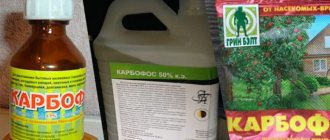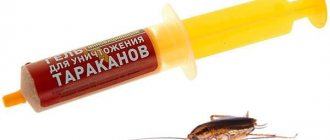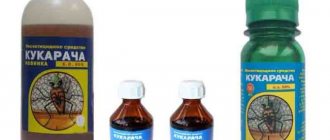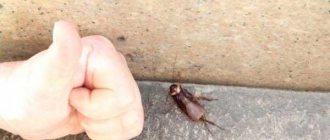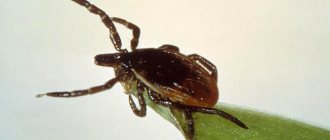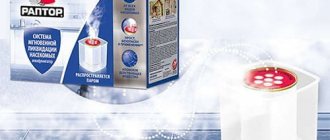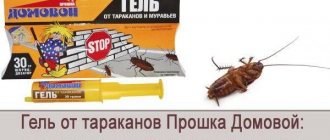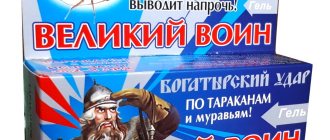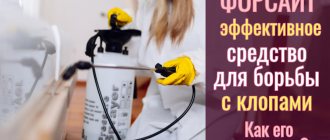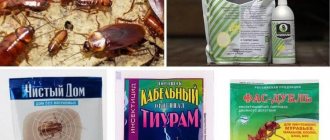Among the most effective remedies for bedbugs are always those that methodically kill not only the parasite, but also do a lot of harm to us people, harm pets and, most importantly, small children.
As a result, when you decide to fight bedbugs on your own, you have to choose not only an effective, but also a remedy suitable for your task. One of these can safely be called poisons for bedbugs based on chlorpyrifos .
Physical and chemical properties
Chlorpyrifos in its pure form appears as white crystals. The product is stable in acidic and neutral environments. At the same time, it quickly disintegrates under the influence of alkalis.
The main physical characteristics of the product include:
- steam pressure – 1.9∙10-5 millimeters of mercury;
- melting point – 41.5-43.5 degrees;
- molecular weight – 350.6.
Solubility indicators differ depending on the liquid:
- in water at a temperature of 25 degrees – 2 milligrams per 1 liter;
- in benzene – 7900 grams per 1 kilogram;
- in acetone – 6500 grams per 1 kilogram;
- in ethanol – 630 grams per 1 kilogram;
- in xylene – 4000 grams per 1 kilogram.
chlorpyrifos: ecotoxicity
| Index | Meaning | Source / Qualitative indicators / Other information | Explanation | |
| Bioconcentration factor | BCF: | 1374 | A5 | Threshold for concern |
| CT50 (days): | 2.5 | — | ||
| Bioaccumulation potential | — | Calculated | High | |
| Mammals - Acute oral LD50 (mg/kg) | 66 | A5 Rat | High | |
| Mammals - Short-term food NOEL | (mg/kg): | 1 | L2 Rat, 2 years old | High |
| (ppm food): | — | — | ||
| Birds - Acute LD50 (mg/kg) | 13.3 | A5 Common quail | High | |
| Birds - Acute toxicity (CK50 / LD50) | 203 ppm | A5 Mallard duck | — | |
| Fish – Acute 96 hour CK50 (mg/l) | 0.0013 | A5 Rainbow trout | High | |
| Fish - Chronic 21 day NOEC (mg/l) | 0.00014 | A5 Rainbow trout | — | |
| Aquatic invertebrates - Acute 48 hour EC50 (mg/l) | 0.0001 | A5 Daphnia magna (Daphnia major, Large water flea) | High | |
| Aquatic Invertebrates - Chronic 21 day NOEC (mg/L) | 0.0046 | A5 Daphnia magna (Daphnia major, Large water flea) | — | |
| Aquatic crustaceans - Acute 96 hour CK50 (mg/l) | 0.00004 | F4 Mysis shrimp | High | |
| Bottom microorganisms - Acute 96 hour CK50 (mg/l) | 0.00002 | F4 Chironomus mosquito | High | |
| Bottom microorganisms - Chronic 28 day NOEC, static, Water (mg/l) | 0.0001 | F4 Chironomus mosquito | High | |
| Benthic microorganisms - Chronic 28 day NOEC, Sediment (mg/kg) | — | — | — | |
| Aquatic plants - Acute 7 day EC50, biomass (mg/l) | — | — | — | |
| Algae - Acute 72 hour EC50, growth (mg/l) | 0.48 | H4 Unknown species | Moderately | |
| Algae - Chronic 96 hour NOEC, growth (mg/l) | 0.043 | Q2 Unknown species | Moderately | |
| Bees - Acute 48 hour LD50 (µg/individual) | 0.059 | A5 Contact | High | |
| Soil worms - Acute 14-day CK50 (mg/kg) | 129 | A5 Earthworm | Moderately | |
| Soil Worms - Chronic 14-Day Maximum Non-Effective Concentration, Reproduction (mg/kg) | 12.7 | A5 Earthworm | Moderately | |
| Other soil macroorganisms, such as springtails | LR50 / EC50 / NOEC / Action (%) | 0.2 | A5 Tropical white springtail (Folsomia candida) , 35day LC50 Mortality mg/kg | — |
| Other Arthropods (1) | LR50 (g/ha): | 0.2 | A5 Aphidius colemani | Harmfulness at 1 kg/ha |
| Action (%): | 100 | Lethal dose: norm of use of the drug Q2 Galendromus occidentalis | Harmfulness | |
| Other Arthropods (2) | LR50 (g/ha): | 1986 | A5 Predatory mite | Harmless at 1 kg/ha |
| Action (%): | 100 | Lethal dose: norm of use of the drug Q2 Neoseiulus fallacis | Harmfulness | |
| Soil microorganisms | Nitrogen mineralization: no significant effect Carbon mineralization: no significant effect | A5 [Dose: 4.8 kg/ha] | — | |
| Available data on the mesoworld (mesocosm) | NOEAEC mg/l: | 0.1 | A5 EAC | — |
| NOEAEC mg/l: | — | — | — | |
Effect on harmful mechanisms
When parasites enter the body, chlorpyrifos phosphorylates a number of substrates. One of them is considered to be a protein enzyme that is present in nerve tissues. It is called acetylcholinesterase. This substance plays an important role in the transmission of nerve impulses.
The active component belongs to the category of carboxylic acid ester hydrolases. It is predominantly located on the postsynaptic membrane of the synapse and is part of the axon membrane.
Expert opinion
Zarechny Maxim Valerievich
Agronomist with 12 years of experience. Our best country expert.
Ask a Question
Chlorpyrifos and organophosphorus substances, when interacting with esterases, provoke a suppression of their activity. Such elements act as competitive inhibition. Acetylcholinesterase is responsible for the hydrolysis of acetylcholine. As the enzyme is blocked by chlorpyrifos, an accumulation of acetylcholine is observed in the synaptic cleft. This causes a disruption in the transmission of nerve impulses.
As a result, convulsions develop, turning into paralysis. When chlorpyrifos enters the insect's body through the respiratory system, stomach or integument, acetylcholinesterase activity decreases. The product allows you to get rid of bedbugs. It also helps against ants and cockroaches.
See also
Instructions for use of Dividend Supreme, dosage of disinfectant and analoguesRead
Chlorpyrifos is considered more persistent than other organophosphorus elements. Therefore, it exhibits a noticeable intestinal effect. The longer the substance remains active, the more effective it is against gnawing pests. The duration of the effect of the product reaches 40-70 days. The substance remains in the soil for 60-120 days. There is also information that the active component can remain stable in the soil for 2 years.
With the systematic use of chlorpyrifos-based products, group resistance to it develops in some types of parasites.
Reasons for the ban
The ban was quite expected. As EUobserver wrote, back in August 2022, the European Food Safety Authority (EFSA), which assesses the risk of pesticides, stated that these substances have a “potential” genotoxic and neurotoxic effect on the human body, in particular, they cause nervous pathologies in children (significant developmental delays in the first years of life). They supported their arguments with scientific research conducted over the past 20 years.
It is worth noting here that chlorpyrifos has been approved for use in the EU since 2006. But in Germany, Denmark, Ireland, Latvia, Lithuania, Germany, Finland, Slovenia and Sweden it was banned. Gradually, the United States is joining the “club of opponents of chlorpyrifos.” Currently, a ban on the production and sale of one of the most widely used plant protection products in the country has been introduced in the states of California, New York, Hawaii and Maryland. Oregon, Connecticut and New Jersey are considering this issue.
The best drugs based on chlorpypiphos
The substance is present in the following pesticides used in agriculture:
- "Nurbel";
- "Dursban";
- "Nurimet";
- "Sail".
The following substances are usually used in everyday life:
- "Sinuzan";
- "Maxifos";
- "Xulat";
- "Sichlor."
Where will they be tested?
The most important question in this situation is: how can companies check whether there are insecticide residues in exported products? It is easy to check whether the farmer really adhered to the requirements and did not use the drug in his company. But there is no guarantee that an outside farmer will be honest with you. How to identify who slipped the “unclean” goods into the prefabricated shipment? When forming a composite batch, grain traders recommend taking samples from each machine. If the tests show that there are deviations from the norm, then in this case it is easy to calculate from whom the product with insecticide residues came. From someone who has a large batch.
According to Maxim Dobrovolsky, the BiLab laboratory is already receiving requests from agricultural holdings regarding how they can test products at incoming control.
“There are practically no laboratories in Ukraine that could test such a volume of batches with a minimum concentration of chlorpyrifos of 0.01 mg/kg quickly and efficiently. That’s why agricultural holdings turn to us,” he says.
He noted that the analysis is done within one day after receiving the sample. Sampling is carried out either by elevator employees or BiLab specialists. It is important here that the sample is selected correctly, otherwise the result will be incorrect.
Rules of application
When using drugs based on this substance, it is important to follow the instructions. It is recommended to take into account the type of crops being processed:
- Winter rapeseed. It is best to carry out processing in the fall. The product will help destroy cabbage cutworm larvae, moths and other parasites. In spring, the composition is applied before the formation of buds.
- Winter grain plants. In this case, it is worth using the product in autumn and early spring. It helps to cope with bread ground beetle larvae. It is worth completing the processing by the time the ear emerges.
- Peas. The drug helps to destroy gray beet weevils and bruchus. It should be used at the budding stage.
- Sunflower. The product is used to destroy the larvae of winter cutworms and aphids.
- Corn. The composition successfully copes with the larvae of the corn moth and cotton bollworm. The substance should be used before flowering begins.
Security measures
This organophosphate insecticide belongs to hazard class 2. Harm to humans from chlorpyrifos can be caused by failure to comply with precautions and exceeding the permissible dosage of the drug. In this case, speech impairment, dizziness, confusion, vomiting, stomach cramps, muscle tremors, and lacrimation are observed.
Poisoning occurs when inhaling harmful fumes, as well as in the case of prolonged contact of the insecticide with the skin, which leads to disruption of neuromuscular connections.
If alarming symptoms appear, you should immediately leave the room, take activated carbon at the rate of 1 tablet per 10 kg of body weight, wash it down with plenty of water. If your health worsens further, you should seek medical help.
To avoid negative health effects, only one person should be in the room during processing. He must carry out all manipulations with the drug in special clothing, a respirator and rubber gloves. Avoid contact of the working solution with exposed areas and mucous membranes. If this happens, you need to rinse off the product under running water.
After disinfestation, you should thoroughly wash your hands with soap, take a shower and wash your overalls.
Research technology
In the laboratory, tests for the determination of chlorpyrifos and chlorpyrifos-methyl are carried out using gas chromatography-tandem mass spectrometry (GC-MS/MS) technology in multiple reaction monitoring (MRM) mode.
“The determination is carried out according to the European method EN 15662:2018. Briefly the procedure is as follows. A grain sample is ground, a sample is taken for analysis, and extraction is carried out with a water-organic mixture. The resulting extract (extract) is purified according to the method. The resulting purified extract is placed into the device for further testing. The results of chromatographic analysis are processed by qualified personnel. The accuracy and correctness of the results is ensured by the use of certified standard samples and reagents and is confirmed by successful participation in the FAPAS rounds,” says Maxim Dobrovolsky.
